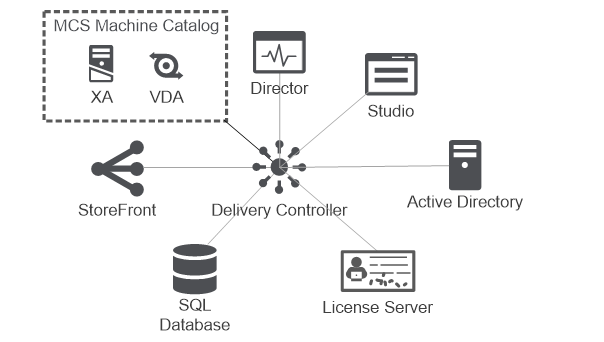Citrix Introduction
Citrix announced that the XenApp product was at end of life and the functionality was integrated into XenDesktop 7.0. Unfortunate for Citrix the customers did not understand this message and there was lots of confusion around this. Citrix responded by re-introducing XenApp again in version 7.5. Actually it was bringing back the original product name and will be based on the new FMA architecture. There are only two different license models available; one for XenApp and one for XenDesktop. The Citrix XenDesktop/XenApp matrix provides a good insight of what the differences between the licenses are. With the release of XenApp/XenDesktop 7.6, many features that were available in XenApp 6.5 but not in previous 7.x releases have been introduced again, so the version 7 release is a real XenApp comparable product.
To explain what XenApp and XenDesktop are becames a bit more complicated, especially because, from a technical standpoint, it’s the same product. In this article I’m going to describe the installation and basic configuration steps for XenApp/XenDesktop 7.6. I try to use the name XenDesktop 7.6 through the article, but hopefully you understand that you can read XenApp here as well (and if I use XenApp by accident, you can also read XenDesktop).
Citrix released their latest XenApp / XenDesktop 7.12 version, what includes many new features, with one in particular, the (re)introduction of the Local Host Cache functionality. The feature to keep your Citrix FMA environment available for new and existing sessions in case of a central site database outage, or even when all the Citrix databases are unavailable. For this particular operation advantage, you won’t need to have a SQL AlwaysOn cluster or mirroring setup anymore, but Citrix’s best practice will always stay to keep using these Microsoft SQL features for the larger – enterprise environments to keep all your Citrix databases high available and to continue all the processes.
In the last year, Citrix released more versions that they did ever before, what proves that Citrix listens to their customers and is evolving more and more to stay the best in desktop end-user experience. This new feature, including the Windows Server 2016 day one support from previous version 7.11, and all the other new 7.12 features makes me curious enough to dive into the XenApp installation process again, what resulted in this blog article.
In the first part I will highlight all the new, most important, Citrix XenApp/XenDesktop 7.12 features, afterwards I will tell in a step-by-step installation guide, how you install and configure a Citrix XenApp 7.12 Desktop Delivery server, the configuration of a Windows Server 2016 master server based on the MCS imaging strategy, the StoreFront configuration part, the setup of a HDX Citrix Policy and as final, the activation of the newest Local Host Cache feature!

Some of the new features are
The (re)introduction of the Local Host Cache technology. What keeps your Citrix environment response for existing and new sessions when the Central database is unavailable (or even all the Citrix database) are unavailable, like mentioned above, for this particular advantage, you won’t need to have a SQL AlwaysOn cluster or mirroring setup anymore, but for larger-enterprises Citrix’s best practices will always stay to keep to configure one of these 2 functions. The LHC feature creates a local database on the Delivery Controller(s) and uses a Microsoft SQL Server Express (LocalDB) database to store the information, and will update this local database over the new Sync/High Availability service, these services are installed on the Delivery Controllers when updating/installing your Citrix environment to 7.12. The Broker service will detect if there there is no connection possible between the Delivery Controller and the Central Site Database, and will tell the High Availability Service to listen to the LocalDB (LHC). Also mentioned above, LHC for FMA is called a re-implementation by different websites, because it already existed in the Citrix IMA Architecture (XenApp 6.5), but the feature is not exactly the same as LHC for FMA. Citrix completely re-build/re-designed the feature for FMA, and also added the support for XenDesktop – static VDI – sessions, what IMA doesn’t have! So what are you waiting for? If you are still on XenApp 6.5 because of this FMA feature limitation, now it is the time to upgrade your environment!
The introduction of HTML5 video with redirection, with 7.12 and Receiver 4.6, you can now offload your HTML5 video’s to your client (only for internal websites yet);
Azure Resource Manager connection enhancements, Azure environment support, Azure Hybrid Use Benefits support and Wizard changes in Studio (Connection Details page);
Better control of individual app and desktop publishing across machine;
The optimization of low-bandwidth connections, by providing a new 8-bit Thinwire color depth for simple graphics policy setting;
Citrix Director includes new and enhanced features, User-friendly Connection and Machine failure descriptions, Increased historical data availability in Enterprise edition, Custom Reporting and Automate Director notifications with SNMP traps;
Intelligently stagger maintenance reboot cycles to minimize user impact;
For all the new features and more detailed information, please check this link
The installation guide will include the following Citrix Components
Desktop Delivery Controller setup
License server
VDA installation on Server 2016
Configuration of Machine Catalog/Delivery Group
Add Delivery Controller to StoreFront
VMware host connection setup
Configure Published Application
Configuration of HDX (High Experience) Citrix Policy
Local host cache activation
Requirements:
Separate StoreFront Server (if you haven’t, please check my StoreFront blog)
Minimum of SQL Server 2008 R2 SP2 or higher
Valid Citrix XenApp SA license (or a trial license, request here)
VMware ESX 5 or higher, including vCenter
Active Directory Domain
No comments:
Post a Comment